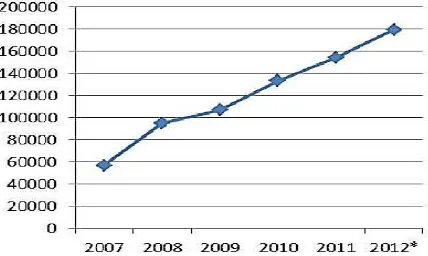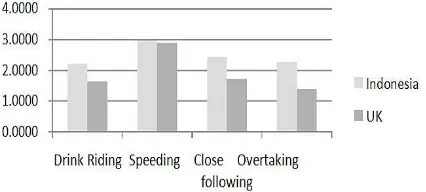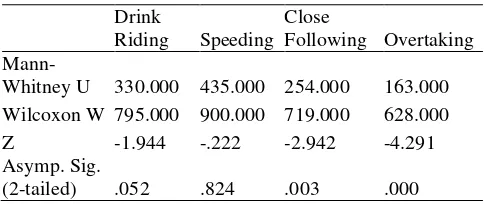THE EFFICACY OF MOTORCYCLE TRAINING TO REDUCE SELF-REPORTED
NEGATIVE BEHAVIOUR AND ATTITUDE (CASE STUDY IN UK AND INDONESIA)
Winna Justiana Sirait
Directorate General of Civil Aviation, Ministry of Transportation Email: [email protected]
Sigit Priyanto
Transport System and Engineering, Gadjah Mada University, Yogyakarta Email: [email protected]
Samantha Jamson
International Activities Safety and Technology Group Institute for Transport Studies, University of Leeds Email: [email protected]
ABSTRACT
Motorcyclists are vulnerable road users because of their particular combination of physical vulnerability. Motorcyclists’ training and licensing system have already implemented in so many countries in the world particularly developed countries. In the other hand, there are countries, particularly developing countries, where motorcyclists are less regulated in term of licensing, enforcement, and insurance. Therefore the objective of this research are to analyses the behavior and attitude of motorcyclists in Yorkshire and Humber Region (UK) and Jakarta (Indonesia), and to analyses the efficacy of motorcycle training in UK to influence the self-reported negative behavior and attitude of motorcyclists.
Motorcycle Rider Behavior Questionnaire (MRBQ) and Motorcyclists Attitude Questionnaire (MAQ) are used to conduct this study. The Mann Whitney test is used to evaluate the significance different of the mean score, which obtained from the survey in each country (UK and Indonesia).
Mean score computation showed that Yorkshire and Humber Region’s respondents have better mean score than Jakarta’s respondents. However Mann Whitney test showed that the mean score different is not significant for speed violation factor in MRBQ and drink driving and speeding factor in MAQ.
Keywords: motorcyclist, motorcycle training, Motorcycle Rider Behavior Questionnaire (MRBQ), Motorcyclist Attitude
Questionnaire (MAQ).1 INTRODUCTION
Motorcyclists are vulnerable road users because of their particular combination of physical vulnerability. Certain aspects of control skill are very demanding for motorcyclist because it is more difficult to recover from instability when riding a motorcycle compared to driving a car (Elliot et al., 2007 and Mannering and Grodsky, 1995). Department for Transport (2010) also pointed out that motorcycle riders are at around 30 times more likely to death in a crash than driver of other motor vehicle per mile travelled.
Study by Suraji et al. (2007) (as cited in Indriastuti and Sulistio, 2010) shows that human factor is the major factor that contribute to the occurrence of casualties. Therefore preventive measure to reduce human factor in causing accident is important to do.
Motorcyclists’ training and licensing system have
already implemented in so many countries in the world
particularly developed countries such as United Kingdom, European Countries, USA, and Australia. In
these countries, motorcyclists’ safety has been a topic of concern to be treated, to increase awareness of road safety and reduce fatalities of road users.
negative behavior and attitude by comparing two samples, which are UK (Yorkshire and Humber Region) and Indonesia (Jakarta).
The research would be focused on motorcyclists in Yorkshire and Humber Region (United Kingdom) and Jakarta (Indonesia). The type of motorcycle was analyzed in this study is limited two wheeled vehicles. This type of motorcycle is chosen because in both countries this type of motorcycle is the most common to be used on the road.
The objectives of this research are:
a) To analyses the efficacy of motorcycle training in UK to influence the self-reported negative behavior of motorcyclist.
b) To analyses the efficacy of motorcycle training in UK to influence the self-reported negative attitude of motorcyclist.
c) To analyses the behavior and attitude of motorcyclist in UK (Yorkshire and Humber Region) and Indonesia (Jakarta).
2 LITERATURE REVIEW
2.1
UK’s Current ConditionsStatistic of Department for Transport (2012) shows that the number of licensed motorcycle in Yorkshire and Humber region has increased from 78,082 in 20000 to 99,172 in 2012, albeit there is decrease in 2008 to 2012 (see Figure 1). However, according to Department for Transport (2010; 2011), number of killed and seriously injured of motorcyclists in UK indicated declined trend as shown in Table 1.
According to Sudlow (2003) motorcycle training program evolved in 1978 from the British Institute of
Traffic Education Research ‘Two -Wheel Tech-In” scheme and later becoming better known as ‘Star
Rider’ program. This program engage d three -stage process of training and certification: Bronze, Silver and Gold certification.
In December 1990, Compulsory Basic Training was introduced as a requirement of new rider or learner riders before they are allowed to ride on public road.
After complete the CBT and get full license, rider can voluntarily follow the advanced motorcyclist training that already in varied name later on.
Figure 1. Licensed motorcycle in Yorkshire and Humber Region (Department for Transport Statistics, 2012). Compulsory Basic Training was introduced in 1990 as
an effort to improve the motorcyclists’ safety. All
learner riders required to complete the CBT before they are allowed to ride on the road . According to Compulsory Basic Training syllabus and guidance by Driving Standard Agency (2012), CBT involved five elements, which are introduction, practical on-site training, practical on-site riding, practical on-road training, and practical on-road riding.
There are several advanced riding program that provided by Driving Standard Agency or Police Department to improve motorcyclist skill and reduce
motorcyclists’ casualties. Motorcyclist can follow
advanced riding program voluntarily to check their skill and improve. This program can give advantages to motorcyclist who want to get higher entitlement or for motorcyclist who returning from break.
2.2 Indonesia’s Current Conditions
Motorcycle is dominant mode on Indonesia’s road generally. According to Directorate General of Land Transportation (2013), the average growth of motorcycle ownership in Indonesia is 12 .2% per year for period 2007 -2012. In 2012, approximately there are almost 74.6 million motorcycles in Indonesia as shown in Figure 2 or for about 74% of mode share.
Table 1. Killed and seriously injured of motorcyclists in UK (Department for Transport, 2012)
2000 2001 2002 2003 2004 2005 2006 2007 2008 2009 2010 2011 Motorcyclist and
passengers
Killed 605 583 609 693 585 569 599 588 493 472 403 362
Figure 2. Motorcycle ownership in Indonesia (Directorate General of Land Transportation, 2013).
In line with the growth of motorcycle ownership, the number of fatalities in Indonesia is also shows an increase every year as shown in Figure 3. It is recorded that the average growth of motorcycle casualties in Indonesia is 27.2% per year for period 2007-2012. In 2012, approximately motorcyclist count for almost 75% of number of casualties.
Figure 3. Motorcycle casualties in Indonesia (Direktorat Jenderal Perhubungan Darat, 2013).
Training is not a requirement to apply for driving license in Indonesia, therefore motorcycle training is hardly found in Indonesia. People tend to learn motor cycling from their parents, friends, siblings, their other family member, or learn it their selves. Even for car driving license, training is not a requirement, however unlike motorcycle training agency, training agency for car driving can be found in almost all big cities.
3 THEORETICAL BASIC
3.1 Training Performance in Different Countries
Several studies have evaluated the performance of motorcycle training in reducing negative behavior or attitude. This evaluation is necessary in order to improve the licensing system in those countries and reduce casualties of motorcyclist. However different studies give different result regarding to the
effectiveness of motorcycle training in improving
motorcyclists’ safety. Perceived skill after
motorcyclists completed training is often become the major factor that it is not necessarily true that
motorcycle training can improve motorcyclists’ safety
by reducing negative behavior and attitude or by reducing number of fatalities in a region.
In Connecticut, USA, the study was conducted by Davis (1997). Davis examined the motorcycle training program that already in operation in Connecticut, Motorcycle Operator Training Program (CONREP). According to survey and analysis of accident records, the study shows that accident rate is about one-fifth lower for those who graduates from CONREP. This result was found to be significant at the 95% confidence level and CONREP graduates had less severe accidents than non-graduates. In addition, the study also shows that nearly every CONREP student agree that the training found to be beneficial.
A study by SWOV (2013) evaluated the advanced rider
training for motorcyclists ‘ART Risk’ that offered by
the Royal Dutch Motorcyclists Association. This one day training covers both theoretical and practical courses that focus on timely perception and recognition of hazard in traffic instead of how to recover from skid or emergency stop. Avoiding hazardous situation is better to be taught to motorcyclist rather than how to deal with it. The study shows positive effect of the one day training to the total 222 participants completed the study. A few months after the training, the trained group was showed safer riding behavior, and the negative result of motorcycle training such as skills overestimation is appeared to have been averted. However, the permanent effect of the one day training has not yet determined, further study still has to carry to answer the questions.
4
RESEARCH METHODOLOGY4.1
ParticipantsParticipants from United Kingdom are limited for those who live in Yorkshire and Humber region and participants from Indonesia is limited for those who live in Jakarta region. The number of participants is 30 from each country. According to Gay and Diehl (1992), 30 participants per group are often cited as minimum and sufficient enough to conduct the research.
The participants are randomly chosen from each region of the case study. Moore and McCabe (2006) define that random sample is a sampling technique to select
such a way, so that every individual in the population has an equal chance to be selected.
4.2 Questionnaire
The questionnaire for this research consists of three sections. First section will ask the background and riding experience of a respondent. Second section will ask the questions related to riding behavior, which use the items from Motorcycle Behavior Questionnaire (Elliot et al., 2007). The last section will ask questions related to rider attitude, which use the items from Theory of Planned Behavior.
The origin of MRBQ (Motorcycle Rider Behavior Questionnaire) is Driver Behavior Questionnaire (DBQ) that developed by Reason et al (1990) to distinct between errors, violations and lapses in a car accident and develops instruments to measure driver behavior.
MRBQ also developed by Elliot et al. (2007) as a ‘ self-report instrument’ to measure motorcyclists’ behavior. MRBQ is developed from 50 items of DBQ by selecting the relevant items to motorcyclists, for
example ‘’exceed the speed limit in the residential area’’, and by adding new specific items for motorcyclists, for example “ride between two lanes of fast moving traffic” (Elliot et al., 2007). The result is
43 items of MRBQ that grouped into five factors: traffic errors, speed violations, stunts, safety equipment, and control errors
Motorcyclists’ attitude questionnaire (MAQ) will be
developed from TPB’s items by adapting the items to
be relevant to motorcyclist. The same as MRBQ, MAQ is also use like scale 6 points (strongly agree to strongly disagree) to describe the respondent agreement towards every items in MAQ. Parker et al. (1992) explained that TPB was applied to four distinct factors that can measure the major issues of car crash occurrence. These factors are drinking driving, following closely to other vehicle, risky overtaking and speeding.
5 ANALYSIS OF EFFICACY OF MOTORCYCLE
TRAINING
5.1 MRBQ
In conclusion, UK’s riders have better mean score for
every factor in MRBQ, as shown in Figure 4. However, the difference has to be tested to check the significance.
Figure 4. MRBQ factor's mean score.
At the confidence level 95%, four out of five factors have significance value or p-value less than 0.05 (Table 2). In this case, null hypothesis will be rejected and alternative hypothesis will be accepted. This indicates that there is significant difference in mean score of traffic errors, stunts, safety equipment, and control errors. The only factor with null hypothesis being accepted is speed violation. Thus, can be concluded that the motorcycling license in UK improve the behavior of motorcyclist to be less frequent do negative behavior in MRBQ items.
Table 2. Mann Whitney Statistics Test Traffic lower mean score in self-reported negative motorcycle
attitude questions. This indicates that UK’s riders are
more likely to be disagreeing towards the majority of
negative attitudes. Similar to the speed violation’ mean score in MRBQ, speeding’s mean score also shows a slight difference between two samples. Indonesia’s
riders claimed to be more likely do speeding and that behavior appears to be reflected in their attitude towards speeding.
Astounding result occurred in drink riding’s mean
score for Indonesia’s rider. This is quite
contradictory to the public belief to not drinking. For
being less regulated is very likely to be the cause of
this condition, because the item drink riding will
“lead to my being banned from riding” has the
highest mean score (2.57), with a few respondent’s
claimed to be strongly agree to this attitude.
Table 3. Mann Whitney Test Statistics Drink Wilcoxon W 795.000 900.000 719.000 628.000 Z -1.944 -.222 -2.942 -4.291 Asymp. Sig.
(2-tailed) .052 .824 .003 .000
At the confidence level 95%, speeding and drink riding are the factor with p-value more than 0.05 (Table 3). This indicates that the mean score difference between two sample group is not significant, or more likely to be the same. However, the significance value of drink riding is slightly passing 0.05. Thus, it is can be concluded that motorcycling training also influence the close following and overtaking attitude of motorcyclist in UK.
6 CONCLUSIONS
The mean score of each factor in Motorcycle Rider Behavior Questionnaire and Motorcycle Attitude Questionnaire shows that UK’s riders have better behavior and attitude in motorcycling. However,
speeding appears to be a major issue of UK’s rider. The
mean score of speeding factor both in behavioral questionnaire and attitude questionnaire show the highest value. This possibly indicates that training intervention does not work really well to reduce speeding behavior. Therefore other intervention to reduce speeding behavior is necessary to do by the government.
Two surprising results apparently come from Indonesia’s respondents. First, there are two
contradictory to the public belief towards ‘drinking’. However, Indonesia’s respondents have the worse
mean score in every factor that tested, which is quite expected because the motorcycle licensing system in
Indonesia did not required the license applicant to complete any training.
This study applies Mann Whitney Test to analyses the efficacy of motorcycle training that already implemented in UK. The result is four of five MRBQ factors have p-value less than 0.05. This indicates that the mean score difference between two samples is significance for four factors excluding speeding. This can be concluded that motorcycle training is effective to influence the negative behavior of motorcyclists
Rather similar result of Mann Whitney Test also obtained for MAQ factors. However, only two factors have p-value less than 0.05, which are close following and dangerous overtaking. Drink riding and speeding has value more than 0.05. This indicates that the mean score of two samples is rather similar, albeit p-value of drink riding (0.052) just slightly passes 0.05. Nonetheless, it also can be concluded that motorcycle training is effective to influence the negative attitude of motorcyclist.
REFERENCES
Darido, G. (2010). Concern Over the Growth of Motorcycles in Cities. [online]. Retrieved May 6,
2013 from:
http://blogs.worldbank.org/transport/concerns-over-the-growth-of-motorcycles-in-cities.
Davis, C. F. (1997). “Evaluation of Community Traffic Safety Programs and Motorcycle Operator Training Programs”. Publication JHR, pp. 97-255. Connecticut department of transport. Newington.
Department for Transport. (2010). Motorcycle Casualties in Reported Road Accident: GB2008. London: Department for Transport.
Department for Transport. (2011). Reported Road Casualties in Great Britain, Annual Report.
Department for Transport. (2012). Transport Statistics Great Britain. [online]. Retrieved May 7, 2013 from:
https://www.gov.uk/government/publications/tra nsport-statistics-great-britain-2012
Directorate General of Land Transportation. (2013).
“Perhubungan Darat Dalam Angka” [Land
Transportation in Number]. A Report, Ministry of Transportation, Jakarta.
Driving Standard Agency. (2012). Compulsory Basic Training (CBT) Syllabus and Guidance Notes.
https://www.gov.uk/government/uploads/system/ uploads/attachment_data/file/2 26643/dsa-cbt-syllabus-guidance-notes.pdf.
Elliot, M. A., Baughan, C. J., and Sexton, B. F. (2007).“Errors and Violation in Relation to
Motorcyclist’ Crash Risk”. Accident Analysis and Prevention.39(2007).pp. 491-499.
Gay, L.R., and Diehl, P.L. (1992). Research Methods for Business and Management, New York: Macmillan.
Indonesian National Police. (2013). Persyaratan Pembuatan SIM Baru [Requirements of Making New Driving License]. [online]. [Accessed 12
July 2013]. Available from:
http://www.polri.go.id/banner/berita/91.
Indriastuti, A. K. and Sulistio, H. (2010). “Motorcycle Accident Model for Severity Level and Collision Type”. International Journal of Academic Research.(2)6, pp. 210-215.



